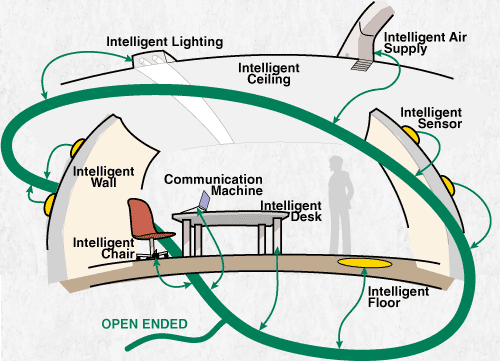
− Ken Sakamura −
TRON (The Real-time Operating system Nucleus) is a project started in 1984 with the objective of constructing ideal computer architecture. It aims to realize a revolutionary new computer system with cooperation from industry and academia.
In recreating computer systems, the TRON project assumes that we will see an advanced computerized society - a cyber society - in the near future. In cyber society, all of the devices, equipment and tools that we use in our daily lives have built-in microcomputers. Furthermore, a variety of different aspects of mankind's activities are supported by having these devices operate cooperatively by interconnecting them with computer networks. Devices with built-in computers and connected to networks are referred to as intelligent objects, and the whole system in which these objects are interconnected and operate cooperatively is called a Highly Functionally Distributed System (HFDS). The realization of HFDS is the most important goal of the TRON project.
Currently the TRON project is advancing in two parallel tiers, fundamental sub-projects and application sub-projects. Fundamental sub-projects are engaged in research into computer systems, one of the component elements of HFDS. In concrete terms, the following sub-projects are being advanced: ITRON (real-time OS specifications for embedded systems), BTRON (OS specifications for PC and workstation and related specifications), CTRON (OS interface specifications for communications control and data processing), TRON electronic device human interface (standard guidelines for the human interface of different types of electronic devices).
In the application sub-project, problems in achieving actual application systems within HFDS are being addressed, undergoing detailed analysis and being overcome. The computerized society of the future is simulated as a mini-model, and the results of architecture developed in fundamental sub-projects are assessed. In overcoming problems, the application projects will use the results of fundamental projects, with fundamental projects using the valuable feedback from applications in their studies.
The Digital Museum may be regarded as one example of an application of a Highly Functionally Distributed System (HFDS), given as the goal of the TRON project. Computers will be embedded in all areas of the museum to have the exhibits perform and to augment the exhibition space. It also became clear that many of the demands for elemental technology on computers which appear in the course of developing digital museums are actually the same as the technology which BTRON is striving towards (for example, the TRON multilanguage environment, high-level data exchange stipulated TAD, hyperlink data construction, etc.). While at once indicating the universal nature of BTRON's technology, it may also be regarded as indirectly indicating the correctness of the direction of technical development in hypermedia which has been carried out up until now.
HFDS : Highly Functionally Distributed System
